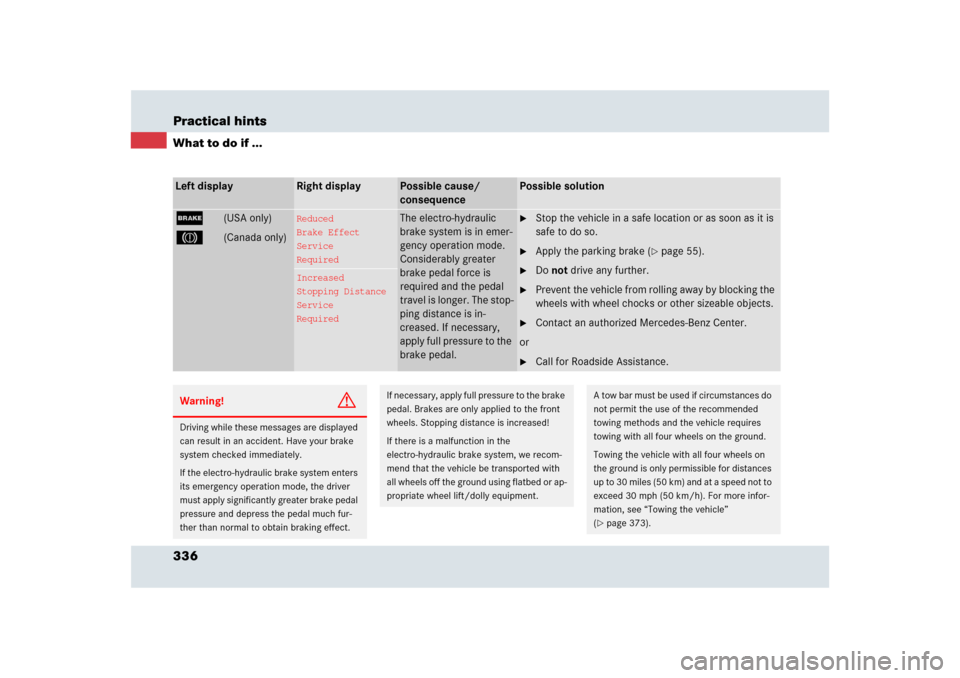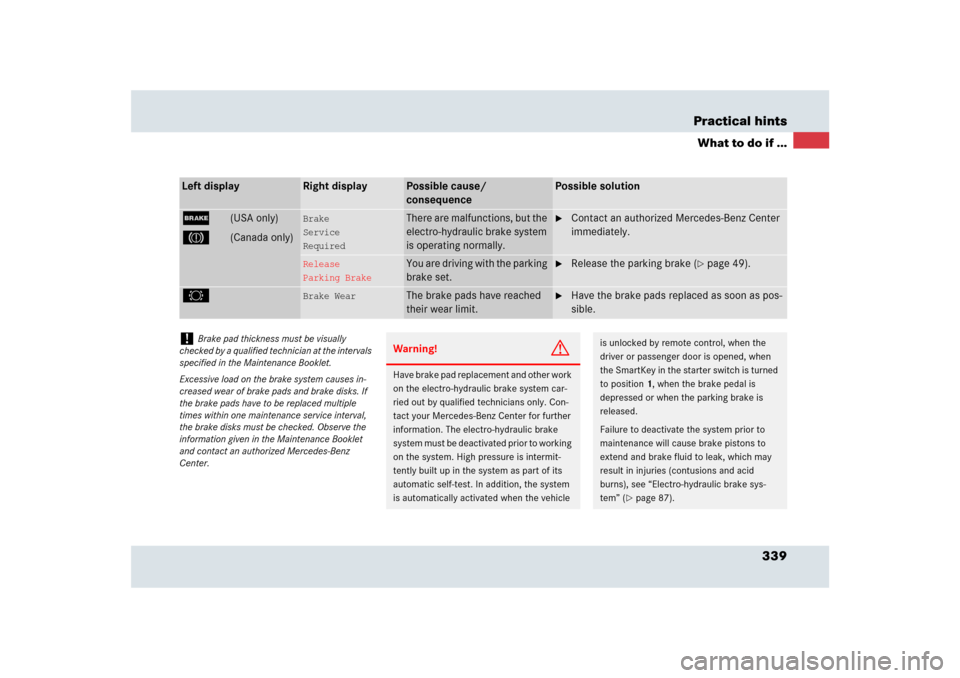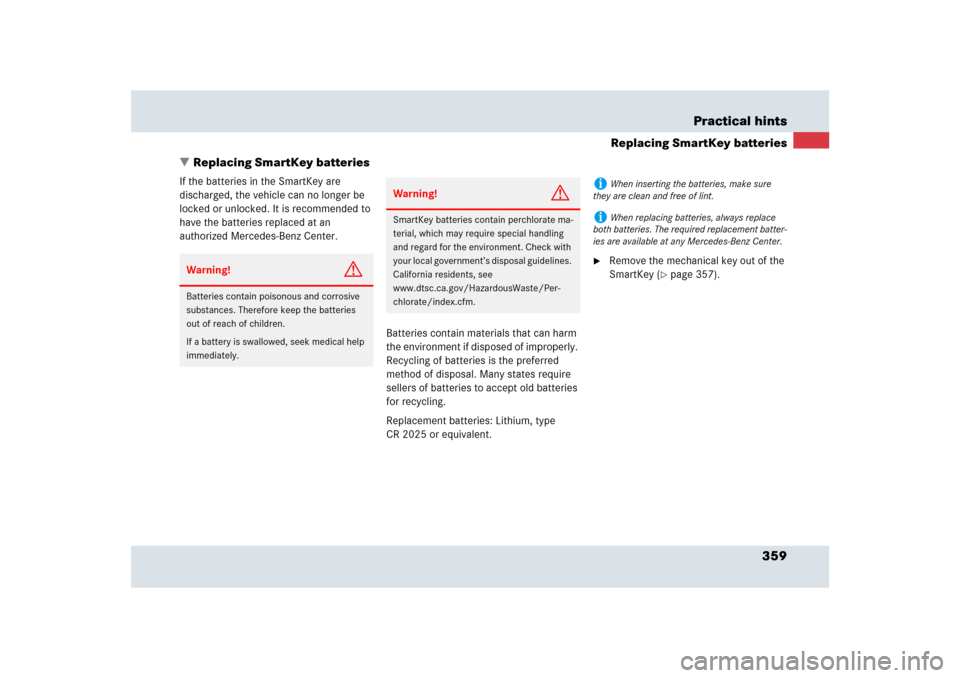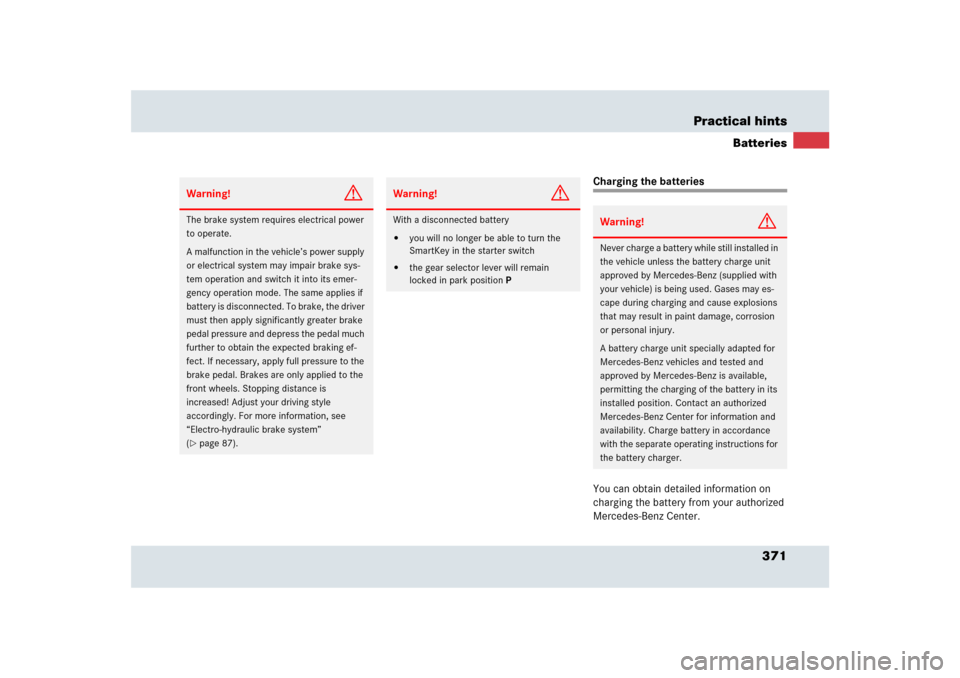Page 336 of 426

336 Practical hintsWhat to do if ...Left display
Right display
Possible cause/
consequence
Possible solution
;
(USA only)
3
(Canada only)
Reduced
Brake Effect
Service
Required
The electro-hydraulic
brake system is in emer-
gency operation mode.
Considerably greater
brake pedal force is
required and the pedal
travel is longer. The stop-
ping distance is in-
creased. If necessary,
apply full pressure to the
brake pedal.
�
Stop the vehicle in a safe location or as soon as it is
safe to do so.
�
Apply the parking brake (
�page 55).
�
Do not drive any further.
�
Prevent the vehicle from rolling away by blocking the
wheels with wheel chocks or other sizeable objects.
�
Contact an authorized Mercedes-Benz Center.
or
�
Call for Roadside Assistance.
Increased
Stopping Distance
Service
Required
Warning!
G
Driving while these messages are displayed
can result in an accident. Have your brake
system checked immediately.
If the electro-hydraulic brake system enters
its emergency operation mode, the driver
must apply significantly greater brake pedal
pressure and depress the pedal much fur-
ther than normal to obtain braking effect.
If necessary, apply full pressure to the brake
pedal. Brakes are only applied to the front
wheels. Stopping distance is increased!
If there is a malfunction in the
electro-hydraulic brake system, we recom-
mend that the vehicle be transported with
all wheels off the ground using flatbed or ap-
propriate wheel lift/dolly equipment.
A tow bar must be used if circumstances do
not permit the use of the recommended
towing methods and the vehicle requires
towing with all four wheels on the ground.
Towing the vehicle with all four wheels on
the ground is only permissible for distances
up to 30 miles (50 km) and at a speed not to
exceed 30 mph (50 km/h). For more infor-
mation, see “Towing the vehicle”
(�page 373).
Page 339 of 426

339 Practical hints
What to do if ...
Left display
Right display
Possible cause/
consequence
Possible solution
;
(USA only)
3
(Canada only)
Brake
Service
Required
There are malfunctions, but the
electro-hydraulic brake system
is operating normally.
�
Contact an authorized Mercedes-Benz Center
immediately.
Release
Parking Brake
You are driving with the parking
brake set.
�
Release the parking brake (
�page 49).
2
Brake Wear
The brake pads have reached
their wear limit.
�
Have the brake pads replaced as soon as pos-
sible.
!
Brake pad thickness must be visually
checked by a qualified technician at the intervals
specified in the Maintenance Booklet.
Excessive load on the brake system causes in-
creased wear of brake pads and brake disks. If
the brake pads have to be replaced multiple
times within one maintenance service interval,
the brake disks must be checked. Observe the
information given in the Maintenance Booklet
and contact an authorized Mercedes-Benz
Center.
Warning!
G
Have brake pad replacement and other work
on the electro-hydraulic brake system car-
ried out by qualified technicians only. Con-
tact your Mercedes-Benz Center for further
information. The electro-hydraulic brake
system must be deactivated prior to working
on the system. High pressure is intermit-
tently built up in the system as part of its
automatic self-test. In addition, the system
is automatically activated when the vehicle
is unlocked by remote control, when the
driver or passenger door is opened, when
the SmartKey in the starter switch is turned
to position1, when the brake pedal is
depressed or when the parking brake is
released.
Failure to deactivate the system prior to
maintenance will cause brake pistons to
extend and brake fluid to leak, which may
result in injuries (contusions and acid
burns), see “Electro-hydraulic brake sys-
tem” (
�page 87).
Page 355 of 426
355 Practical hints
What to do if ...
Left display
Right display
Possible cause/conse-
quence
Possible solution
K
Top
Not Open / Closed
Completely
The soft top could not be
locked after opening it.
�
Stop the vehicle in a safe location or as soon as it is safe
to do so. Observe the traffic situation around you.
�
Repeat the opening process (
�page 198).
The soft top was not locked af-
ter closing it.
�
Stop the vehicle in a safe location or as soon as it is safe
to do so. Observe the traffic situation around you.
�
Lock the soft top (
�page 198).
Page 357 of 426
357 Practical hints
Unlocking in an emergency
�Unlocking in an emergency
Unlocking the vehicle
Unlocking the trunk
If you cannot unlock the trunk with the
SmartKey, open the trunk with the
mechanical key.
The handle is located above the rear
license plate recess.1Mechanical key locking tab
2Mechanical key
�
Press locking tab1 in the direction of
arrow and, at the same time, remove
mechanical key2 completely out of
the housing.
Trunk lid lock3Unlocking�
Insert the mechanical key in the trunk
lid lock.
�
Perform the following two steps
simultaneously:�
Turn the mechanical key
counterclockwise to the stop, to
position3.
�
Pull the trunk lid handle and lift the
trunk lid.
i
Unlocking the trunk with the mechanical key
will trigger the anti-theft alarm system when the
door is opened.
To cancel the alarm, insert the SmartKey in the
starter switch.
Page 358 of 426
358 Practical hintsUnlocking in an emergencyUnlocking the driver’s door
If you can no longer lock or unlock the
doors using the SmartKey, unlock the
driver’s door using the emergency release
catch.The emergency release catch is located on
the left side in the trunk.
1Emergency release catch
�
Unlock the trunk (
�page 357).
�
Pull emergency release catch1.
The door is unlocked.
�
Open the door in the normal way.
�
Contact an authorized Mercedes-Benz
Center.
i
Unlocking the driver’s door with the emer-
gency release catch will trigger the anti-theft
alarm system.
To cancel the alarm, insert the SmartKey in the
starter switch.
i
If it still is not possible to unlock the door,
pull more firmly on the emergency release catch.
Page 359 of 426

359 Practical hints
Replacing SmartKey batteries
�Replacing SmartKey batteries
If the batteries in the SmartKey are
discharged, the vehicle can no longer be
locked or unlocked. It is recommended to
have the batteries replaced at an
authorized Mercedes-Benz Center.
Batteries contain materials that can harm
the environment if disposed of improperly.
Recycling of batteries is the preferred
method of disposal. Many states require
sellers of batteries to accept old batteries
for recycling.
Replacement batteries: Lithium, type
CR 2025 or equivalent.
�
Remove the mechanical key out of the
SmartKey (
�page 357).
Warning!
G
Batteries contain poisonous and corrosive
substances. Therefore keep the batteries
out of reach of children.
If a battery is swallowed, seek medical help
immediately.
Warning!
G
SmartKey batteries contain perchlorate ma-
terial, which may require special handling
and regard for the environment. Check with
your local government’s disposal guidelines.
California residents, see
www.dtsc.ca.gov/HazardousWaste/Per-
chlorate/index.cfm.
i
When inserting the batteries, make sure
they are clean and free of lint.
i
When replacing batteries, always replace
both batteries. The required replacement batter-
ies are available at any Mercedes-Benz Center.
Page 360 of 426
360 Practical hintsReplacing SmartKey batteries1Mechanical key
2Unlocking the battery compartment
3Removing the battery compartment
4Slide�
Insert mechanical key1in side
opening, push gray slide4 in direction
of arrow2.
The battery compartment is unlatched.
�
Pull battery compartment out of the
housing in direction of arrow3.5Battery
6Contact spring
�
Remove the discharged batteries.
�
Using a lint-free cloth, insert new
batteries5 under the contact
spring6 with the plus (+) side facing
up.
�
Return battery compartment into
housing until it locks into place.
�
Slide mechanical key1 back into the
SmartKey.
�
Check the operation of the SmartKey.
Page 371 of 426

371 Practical hints
Batteries
Charging the batteries
You can obtain detailed information on
charging the battery from your authorized
Mercedes-Benz Center.
Warning!
G
The brake system requires electrical power
to operate.
A malfunction in the vehicle’s power supply
or electrical system may impair brake sys-
tem operation and switch it into its emer-
gency operation mode. The same applies if
battery is disconnected. To brake, the driver
must then apply significantly greater brake
pedal pressure and depress the pedal much
further to obtain the expected braking ef-
fect. If necessary, apply full pressure to the
brake pedal. Brakes are only applied to the
front wheels. Stopping distance is
increased! Adjust your driving style
accordingly. For more information, see
“Electro-hydraulic brake system”
(�page 87).
Warning!
G
With a disconnected battery�
you will no longer be able to turn the
SmartKey in the starter switch
�
the gear selector lever will remain
locked in park positionP
Warning!
G
Never charge a battery while still installed in
the vehicle unless the battery charge unit
approved by Mercedes-Benz (supplied with
your vehicle) is being used. Gases may es-
cape during charging and cause explosions
that may result in paint damage, corrosion
or personal injury.
A battery charge unit specially adapted for
Mercedes-Benz vehicles and tested and
approved by Mercedes-Benz is available,
permitting the charging of the battery in its
installed position. Contact an authorized
Mercedes-Benz Center for information and
availability. Charge battery in accordance
with the separate operating instructions for
the battery charger.